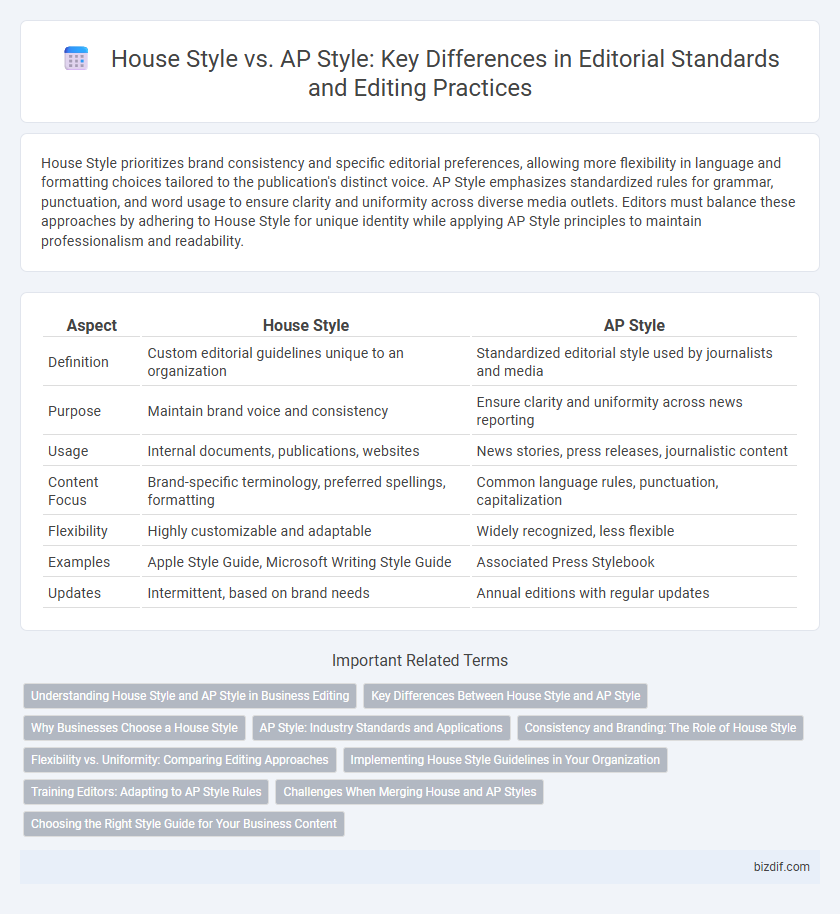House Style prioritizes brand consistency and specific editorial preferences, allowing more flexibility in language and formatting choices tailored to the publication's distinct voice. AP Style emphasizes standardized rules for grammar, punctuation, and word usage to ensure clarity and uniformity across diverse media outlets. Editors must balance these approaches by adhering to House Style for unique identity while applying AP Style principles to maintain professionalism and readability.
Table of Comparison
| Aspect | House Style | AP Style |
|---|---|---|
| Definition | Custom editorial guidelines unique to an organization | Standardized editorial style used by journalists and media |
| Purpose | Maintain brand voice and consistency | Ensure clarity and uniformity across news reporting |
| Usage | Internal documents, publications, websites | News stories, press releases, journalistic content |
| Content Focus | Brand-specific terminology, preferred spellings, formatting | Common language rules, punctuation, capitalization |
| Flexibility | Highly customizable and adaptable | Widely recognized, less flexible |
| Examples | Apple Style Guide, Microsoft Writing Style Guide | Associated Press Stylebook |
| Updates | Intermittent, based on brand needs | Annual editions with regular updates |
Understanding House Style and AP Style in Business Editing
House style in business editing refers to a customized set of guidelines created by organizations to maintain consistency in tone, formatting, and terminology across all documents. AP Style, established by the Associated Press, provides a standardized framework widely used in journalism and business communications for clarity, brevity, and uniformity. Understanding the differences between house style and AP Style is crucial for editors to ensure that content aligns with company branding while adhering to recognized industry standards.
Key Differences Between House Style and AP Style
House style customizes writing rules to fit a specific publication's brand, emphasizing consistency in voice, terminology, and formatting unique to the organization. AP Style provides a standardized set of editorial guidelines widely used by journalists for clarity, brevity, and uniformity across media outlets. Key differences include the treatment of abbreviations, numerals, and punctuation, with house styles often adapting these elements to suit audience preferences and brand identity, whereas AP Style adheres to strict, conventional rules.
Why Businesses Choose a House Style
Businesses choose a house style over AP Style to maintain consistent branding and voice across all communications, which strengthens customer recognition and trust. A house style allows customization tailored to industry-specific terminology and audience preferences, ensuring clarity and relevance in messaging. Consistency in language and formatting provided by a house style reduces editing time and errors, enhancing overall productivity in content creation.
AP Style: Industry Standards and Applications
AP Style is the preferred standard across journalism and media industries for its clarity, consistency, and broad acceptance, ensuring uniformity in news writing and reporting. It emphasizes concise language, standardized abbreviations, and specific rules for numbers, dates, and titles, facilitating seamless communication within and across organizations. Major news organizations like The Associated Press, CNN, and Reuters utilize AP Style to maintain professional editorial standards and enhance reader comprehension.
Consistency and Branding: The Role of House Style
House style ensures consistency and reinforces branding by providing tailored guidelines that reflect a company's unique voice and values across all content. Unlike AP Style, which standardizes grammar and punctuation for broad media use, house style allows customization of language, tone, and terminology specific to a brand's identity. This focused consistency enhances brand recognition and builds a cohesive reader experience across all communications.
Flexibility vs. Uniformity: Comparing Editing Approaches
House Style offers flexibility by allowing editors to tailor language, tone, and formatting to fit a specific brand identity or audience, fostering a unique and consistent voice. AP Style emphasizes uniformity, providing a standardized set of grammar, punctuation, and usage rules widely recognized in journalism to ensure clarity and professionalism across various publications. Choosing between House Style and AP Style depends on whether the priority is adapting content to a distinct brand or maintaining broad consistency and credibility in external communications.
Implementing House Style Guidelines in Your Organization
Implementing house style guidelines ensures consistency and clarity across all organizational content, reflecting the brand's unique voice and values more effectively than strict adherence to AP Style. Tailored house style manuals address industry-specific terminology, preferred grammar usage, and formatting rules that align with internal communication goals. Training editors and writers in these customized standards enhances content quality while maintaining professionalism and audience engagement.
Training Editors: Adapting to AP Style Rules
Training editors to adapt from house style to AP style requires a focused understanding of AP's emphasis on brevity, clarity, and standardized grammar. Editors must internalize AP's specific rules on punctuation, capitalization, and abbreviation to ensure consistent application across all content. Continuous practice with AP Style's updates further enhances editors' proficiency and editorial accuracy in news and media environments.
Challenges When Merging House and AP Styles
Merging House Style and AP Style presents challenges such as inconsistent capitalization, punctuation, and date formats that can confuse readers and slow down the editing process. Editors must carefully balance company-specific preferences with AP's widely accepted guidelines to maintain clarity and professionalism. Frequent style clashes require creating comprehensive style sheets and training to ensure smooth integration and consistency across all content.
Choosing the Right Style Guide for Your Business Content
Choosing the right style guide for your business content depends on your target audience and industry standards. House style offers customized guidelines tailored to your brand's voice and consistency, while AP Style provides widely recognized rules favored by journalists and media organizations for clarity and brevity. Consider factors such as content format, publication frequency, and reader expectations to ensure your editorial approach enhances professionalism and readability.
House Style vs AP Style Infographic

 bizdif.com
bizdif.com